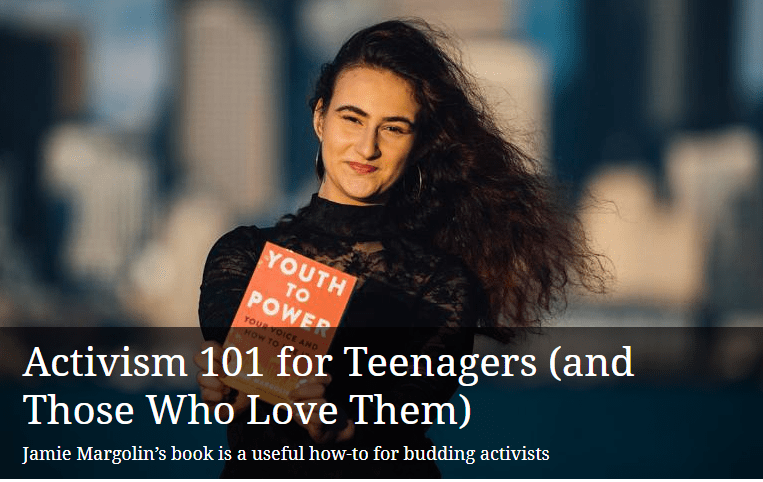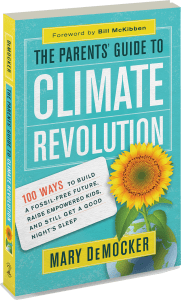Read Mary’s Review of Jamie Margolin’s New Book!
Click here to see the article on sierraclub.org
In my work as a climate activist, I meet many adults living or working with children who suffer from eco-anxiety as well as kids of all ages eager to help build a better world. This is why I eagerly anticipated Jamie Margolin’s new book, Youth to Power: Your Voice and How to Use It (June 2020). I wished for an inspiring how-to guide written by a teen that I could recommend to kids and the adults who care about them.
I also wanted a book like this for my own children, 20 and 24, who, as we careen into the 2020 election during a pandemic, fear that US political dysfunction will destroy democracy, freedom, and the natural world that supports their lives. “I know we’ve got to change everything,” my 20-year-old said recently. “I’m just not sure where to begin right now.”
Four years ago, Jamie Margolin felt the same way. “I was an insecure 14-year-old, worried and scared about the state of the world, with no clue how to get started,” she writes in the introduction to her book.
Margolin grew up watching climate documentaries and writes that she was “filled with dread and fear” for her future. When she found herself yelling at the TV during the 2016 election campaign, she took the activism plunge, working to get out the vote. She later joined grassroots climate groups but didn’t feel heard as a young person, so she founded Zero Hour, an international youth climate justice organization that helped inspire Greta Thunberg and the School Strike for Climate movement. (Thunberg wrote the book’s foreword).
Today, Margolin is a globally recognized leader, co-executive director of Zero Hour, and a plaintiff in a lawsuit against the state of Washington for destroying the climate that her generation needs for survival. And the grassroots activism guidebook she just released far exceeds my hopes.
Youth to Power is a powerful toolkit for revolution. It’s organized into 18 chapters, each of which is followed by brief interviews with young activists working on different social and environmental justice issues. Margolin, who is Colombian American and a lesbian, fights for LGBTQ rights as well as climate justice, championing intersectionality between movements for justice. To that end, she offers strategies that young activists can use for any cause, anywhere.
Margolin begins by outlining young people’s unique power: “We have the high ground on pretty much any issue you can name,” she writes. “We didn’t create any of the systems of oppression that hold us and our world down.”
Young people, she continues, have no hidden agenda. Their desire for a better world is genuine–they’ll live in it longer than the adults now destroying it—and bring fresh energy to the task of healing it. Margolin explains the stakes—the future of Earth and everything on it—and the reason for her urgency. “If we wait until Generation Z is old enough to be in power,” she writes, “it will be far too late.”
Kids can’t make laws to directly solve the climate crisis, but, she writes, “we do have the power to influence those who have institutional power.” So this is what she focuses on, teaching young people how to leverage their moral authority to make system change.
Margolin walks readers through “Finding Your Why”—why you want to be an activist and what you’re fighting for—and “First Steps.” These include letters to representatives, school projects, volunteerism, and protesting. Is there no school club for what you care about? “Start one,” Margolin advises and tells readers how.
Youth to Power presumes no previous knowledge of civics or activism. Margolin defines terms like “lobbying” and “activism,” and not only describes an “op-ed” but also shows you her first one. Her tutorials, such as “Event Organizing 101” and “How to Create a Media Strategy 101,” are concise, easy-to-follow checklists.
“Youth to Power is the book I wished I’d had when I was 13,” Margolin told me. “I didn’t take action on a lot of issues I cared about, because no one was showing me how to get involved. The book is like a present to my younger self, but also for the people who keep asking me, ‘How do I get started?’”
Margolin is candid about her experience with burnout: “After working nonstop for several months, I realized that everything I used to look forward to I dreaded.” Citing Audre Lorde’s credo that self-preservation is an “act of political warfare,” Margolin offers tips and reminders on how to prevent and recover from burnout, including, “It’s OK to take some time to just be a kid.”
It’s hard sometimes to remember this book is written by a teenager. Margolin writes with clarity and maturity about wide-ranging topics such as fundraising, using the arts to broadcast hard-hitting political messages, and navigating the power dynamics within a grassroots organization.
She also writes with youthful candor about the mistakes she hopes to help readers avoid, confessing, “I used to be kind of a dictator very early on in my leadership of Zero Hour.” She then outlines how Zero Hour repaired its group dynamic through honest conversations, new group agreements, and a recommitment to one another.
In places, Margolin is a bit hard on parents, such as when she warns about “stage moms . . . focused on getting their kids famous for being activists.” It’s a fair point, and some young activists will benefit from her tips on boundary-setting with overinvolved parents. But in my experience, most parents are supportive and work hard to help amplify youth voices. Moreover, young people’s needs for parental support vary greatly, depending on a young person’s temperament, the kind of public attention they receive, and—most of all—their age.
I asked Margolin about younger kids who need adult supervision to safely engage in public activism. “[The book’s] main target audience is high-schoolers, because I wrote it in high school,” she acknowledged, “but it can be used as a teaching tool for middle-schoolers and younger kids.”
Ultimately, Margolin’s book feels inclusive and useful for all ages. “Even if it says Youth to Power,” Margolin told me, “adults can also pull a lot of good information about organizing and activism out of it.” In fact, the book ends with a rallying cry for an intergenerational movement for change.
In service to that vision, I suggest getting this book for any young person you know, whether in grade school or graduate school. Give it for birthdays. Give it for holidays. Give it not just to kids but to their parents, principals, teachers, rabbis, counselors, pediatricians, aunts, uncles, grandparents, youth-group leaders, and to your neighborhood’s Little Free Library.
And if a young person you love expresses despair or anxiety over the state of the world, as my kids sometimes do, offer them the message with which Margolin begins her book: “The world of changemaking can be thrilling and empowering, and it can give you a sense of hope and relief in the face of the challenges you’re up against. . . . You (Yes, You!) belong with us, the young people changing the world. You are one of us. Welcome.”



0 Comments